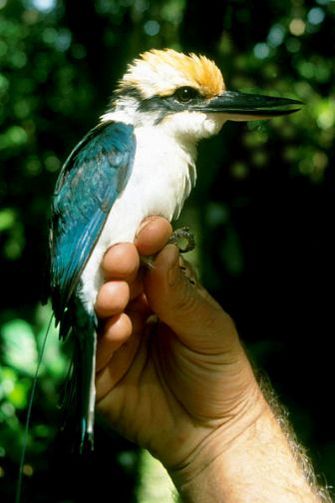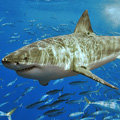« Prev Next »

Biotelemetry and Animal Migration Studies
Biotelemetry enables humans to track migrating animals, once the device has been attached, continuously and, non-invasively in the wild (Bridger and Booth 2003; Bowlin et al. 2005; Axelsson et al. 2007). Telemetric devices can be attached externally or they can be implanted, which tends to reduce stress associated with protruding or physically confining tracking devices (Axelsson et al. 2007). Biotelemetry allows remote tracking of migratory movements in animals over a wide range of body sizes. Moreover, transmitters weighing less than 1 g are able to measure physiological parameters such as heart rate, respiration rate, and wing beat frequency in birds (Cooke et al. 2004; Bowlin et al. 2005).
Biotelemetry equipment now exists for invertebrates, fish, birds, and mammals (Figure 1). Transmitters differ in their ability to transmit signals depending on the environment. For studies on land or in freshwater, radio transmitters are used, but ultrasonic devices are often more reliable in saltwater (Cooke et al. 2004). Radio frequencies of radio transmitters are superior to ultrasonic signals in complexity and distance of signal transmissions, but for short-range transmissions, ultrasonic communication is used (Wolcott 1995; Cooke et al. 2004).

The amount of data that can be generated with biotelemetry devices is astounding. Internal variables can be monitored, such as salinity of body fluids and temperature (Lydersen et al. 2002; Cooke et al. 2004); tiny microphones record sound information, which can be used to infer feeding and social activities; and ever-evolving camera equipment provides visual information (Wolcott 1995; Cooke et al. 2004). Furthermore, swimming depth of aquatic organisms can be estimated based on water pressure (Cooke et al. 2004). Sensors can also document abiotic variables in the migrants' external environments, such as ambient temperature and light conditions, and the salinity of aquatic environments (Bridger and Booth 2003; Cooke et al. 2004).
In 2007, Axelsson et al. developed innovative implantable biotelemetry technology, which enabled researchers to record precise measurements of blood flow and blood pressure in animals. This technology was a ground-breaking approach to recording vital physiological measures with minimal disturbance to the animal. Scientists are now able to record cardiovascular processes in a variety of species, which will likely lead to a deeper understanding of the energy cost and cardiovascular strain of migration on organisms.
Biotelemetry Applications in Research
Invertebrates
In spite of its limitations, biotelemetry has provided some fascinating information on underwater crustaceans. One study by Wolcott (1980) followed ghost crabs (Ocypode quadrata) underwater, where direct observations are impossible. Biotelemetry radio transmitters enabled the researchers to obtain data on activity budgets, thermoregulation, movements, and heart rate (Wolcott 1980; Wolcott & Hines 1989).
Fish
Birds
Mammals
Possible Limitations
Most scientists agree that in order to reduce the impact of transmitters on energy budget and behaviour radio transmitter size should not exceed 2-5% of an organism's body mass (Adams et al. 1998; Cooke et al. 2004). In a study investigating the effect of biotelemetry transmitter implantation on behaviour and physiology of juvenile Chinook salmon (Oncorhynchus tshawytscha), researchers found that adverse effects of transmitter attachment may correlate with both transmitter mass and developmental stage of the organism (Adams et al. 1998). This study demonstrated that biotelemetry transmitters weighing from 4 to 10 % of the study animal's body mass were inappropriate, and significantly impaired swimming ability. It also showed differences in how the devices were attached, and suggested that surgically implanted transmitters may be less detrimental to fish than transmitters inserted into the stomach. Presumably, gastrically implanted transmitters may affect eating behaviour, which would in turn inhibit energy intake and affect the ability to swim (Adams et al. 1998).
Transmitter size also impacts the study of insects, which has thus far been restricted to larger individuals. While battery size is often a limiting factory in transmitter size, there is of course an inherent trade-off between mass and battery life; tiny batteries are required to study small organisms, but are likely to be exhausted quickly. Despite this setback, researchers have been able to gather data on a number of species, such as the desert locust (Schistocerca gregaria), which may provide valuable information for parasite and pest control (Cooke et al. 2004).
There are several reasons for loss of contact with a tagged individual. In larger animals, failure of biotelemetry radio transmitters may be caused by battery depletion. Further, it is not uncommon for transmitters to be destroyed when migrants are hunted and harvested. Loss of contact presents a dilemma for biologists because there is no way for a researcher to conclusively determine the source of radio failure without finding the individual animal (White 1983).
Conclusion
Biotelemetry has provided insight into the mesmerizing world of animal migration. In offering opportunities to track organisms remotely in their natural habitat, this technology has already proven that objective, quantifiable data can best be obtained from organisms navigating through their natural environments, with minimal human interference. As technologies improve, it is likely that biotelemetric devices will become smaller and will acquire the ability to extract even more physiological data. In turn, scientists can anticipate expanding this method to studies of smaller organisms and more challenging scenarios.References and Recommended Reading
Adams, N.S. et al. Effects of surgically and gastrically implanted radio transmitters on swimming performance and predator avoidance of juvenile Chinook salmon (Oncorhynchus tshawytscha). Canadian Journal of Fisheries and Aquatic Sciences 55, 781-787 (1998).
Axelsson M. et al. A novel, fully implantable, multichannel biotelemetry system for measurement of blood flow, pressure, ECG, and temperature. Journal of Applied Physiology 102, 1220-1228 (2007).
Bowlin M.S. et al. Biotelemetry of new world thrushes during migration: Physiology, energetic and orientation in the wild. Integrative and Comparative Biology 45, 295-304 (2005).
Bridger C.J. & Booth R.K. 2003. The effects of biotelemetry transmitter presence and attachment procedures on fish physiology and behaviour. Reviews in Fisheries Science 11, 13-34 (2003).
Butler P.J. et al. Behaviour and physiology of Svalbard barnacle geese Branta leucopsis during their autumn migration. Journal of Avian Biology 29, 536-545 (1998).
Cooke S.J. et al. Biotelemetry: a mechanistic approach to ecology. Trends in Ecology and Evolution 19, 334-343 (2004).
Cooke S.J. 2008. Biotelemetry and biologging in endangered species research and animal conservation: relevance to regional, national, and IUCN red list threat assessments. Endangered Species Research 4, 165-185 (2008).
Kaseloo P.A. et al.1992. A biotelemtry system recording fish activity. Journal of Fish Biology 40, 165-179 (1992).
Leon L.R. et al. Biotelemetry transmitter implantation in rodents: impact on growth and circadian rhythms. American Journal of Physiology - Regulatory Integrative and Comparative Physiology 286, R967-R974 (2004).
Lydersen C. et al. Salinity and temperature structure of a freezing Arctic fjord - monitored by white whales (Delphinapterus leucas). Geophysical Research Letters 29, 2119-2123 (2002).
Voegeli F.A. et al. Ultrasonic telemetry, tracking and automated monitoring technology for sharks. Environmental Biology of Fishes 60,267-281 (2001).
Weng K.C. et al. Satellite tagging and cardiac physiology reveal niche expansion in salmon sharks. Science 310, 104-106 (2005).
White G.C. Numerical estimation of survival rates from band-recovery and biotelemetry data. Journal of Wildlife Management 47, 716-728 (1983).
Wolcott T.G. Optical and radio-optical techniques for tracking nocturnal animals. In A Handbook for Biometry and Radio Trackin, eds. Amlaner C.J. & MacDonald D.W. (Oxford: Pergamon Press, 1980) 279-286.
Wolcott T.G. New options in physiological and behavioural ecology through multichannel telemetry. Journal of Experimental Marine Biology and Ecology 193, 257-275 (1995).
Wolcott T.G. & Hines A.H. Ultrasonic telemetry of muscle activity from free-ranging marine animals: a new method for studying foraging by blue crabs (Callinectes sapidus). Biological Bulletin 176, 50-56 (1989).






























